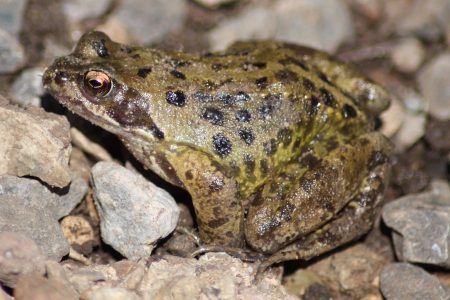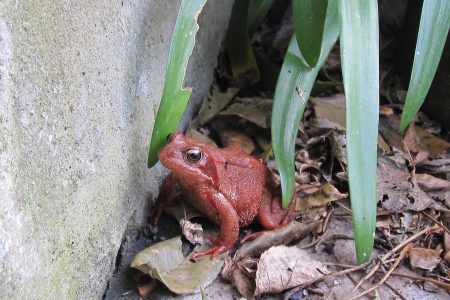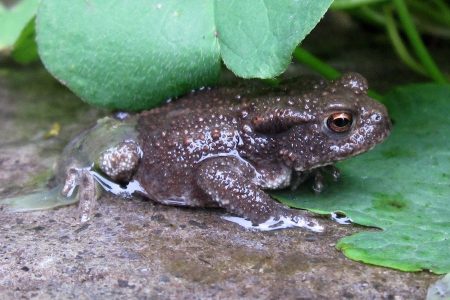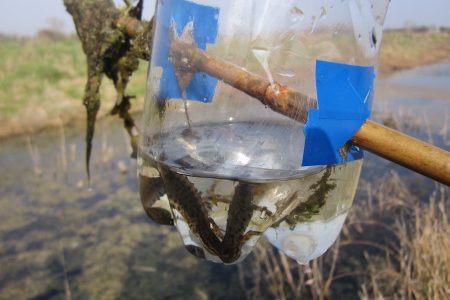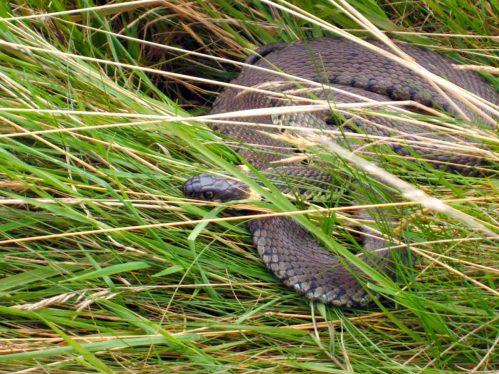
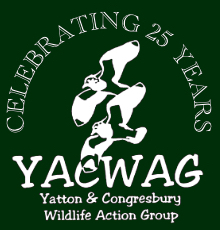
Wildlife
Amphibians & Reptiles
______
YACWAG’s wetland reserves provide habitat for most of the native British amphibians. When mature, amphibians go to water bodies to breed but spend most of their lives on land, in damp hidden places. Many of them can be found in gardens in the local villages.
Frogs
If you have questions about frogs and frogspawn they may be answered by looking at the comprehensive info & advice section of Froglife’s website here
Common frog – Rana temporaria
The common frog is the only one seen in YACWAG’s local area. They like moist places not too far from water and are often found in gardens in the local villages. The commonest breeding places are now artificial garden ponds, but frogs are also found on YACWAG’s nature reserves. Frogs, newts and toads are favourite foods of the grass snake.
Froglife is a national wildlife conservation charity concerned with the conservation of the UK’s amphibian and reptile species and their associated habitats.
Toads
Common toad – Bufo bufo
In the 1980s a toad patrol was set up in Mendip Road, Yatton, to rescue the vast numbers of toads being killed on the roads in the spring. At that time as many as one hundred and fifty per night were gathered into buckets and released near their breeding pond at the end of Chescombe Road. Thousands would be rescued in one season.
Toads are gregarious, gathering in groups to select a mate (the females choose to mate with the loudest croaking males) and laying their spawn communally. Later the black tadpoles swim in large shoals and emerge all at once in June or July as tiny toadlets. Adults hide up for the summer, emerging only to catch insects. In the autumn the adults make their way to suitable hibernation sites. In the 1980s they used to make their way back across the road to sites in village gardens, the churchyard and even as far as Cadbury Hill.
Things are now very different. Amphibians generally are in a sharp decline although locally toads are still doing well. Their tadpoles are found in most of the rhynes on YACWAG’s reserves, and adults are frequently seen in gardens. However, they do not appear to have the mass migrations of the past. Occasional dead ones are seen on local roads, but not in the kind of quantities previously seen. One theory is that habitat on the Strawberry Line and nearby is now much more favourable for toads and they do not need to go so far from their breeding sites.
Froglife is a national wildlife conservation charity concerned with the conservation of the UK’s amphibian and reptile species and their associated habitats.
Newts
Newts have a similar life-style to frogs and toads, breeding in water and spending summer and autumn on land, then hibernating under ground during the winter. YACWAG has constructed some artificial newt hibernacula to provide more habitat for them at Yatton Junction, near the start of the Strawberry Line. In spring newts migrate to water for courtship. The tiny young newts leave the water at the end of summer once they have changed from tadpoles.
Smooth newt – Triturus vulgaris
The smooth newt is by far the commonest newt in the area but sometimes the palmate newt is found in the same local ponds or rhynes. The smooth newt is about 10 cm long and a dull olive colour. When breeding, the males develop bright orange coloration and a high crest along the back and tail. In the smooth newt this is continuous.
Palmate newt – Triturus helveticus
These are smaller than smooth newts at about 75mm long, and have a dark streak across the eye. Breeding males are also distinctive, as they have webbed hind feet, which smooth newts do not, and the crest does not extend to the tail. The colour of breeding males is also paler than in smooth newts, but females of the two species are hard to tell apart.
Great crested newt – Triturus cristatus
This is the largest and rarest British newt (16 cm long) with a dark warty skin. It is fully protected by law and can only be searched for by a person with a licence. They are rare in the area but do turn up occasionally and a population is known from garden ponds between Yatton and Claverham. YACWAG has only recorded one great crested newt on its land, and that was found at Kenn Moor Reserve in a pile of peaty soil.
From time to time a licensed ecologist supervises YACWAG surveys using traps. Plastic traps made from drinks bottles are left overnight in rhynes and ponds, and in the morning any newts found are recorded and released. This enables YACWAG to monitor the success of its habitat management for newts – and to keep an eye out for the rare great crested newt.
YACWAG would be very glad to hear of any great crested newt sightings in the area.
Periodically YACWAG caries out newt surveys which you are welcome to attend. These will be advertised in Events section.
Froglife is a national wildlife conservation charity concerned with the conservation of the UK’s amphibian and reptile species and their associated habitats.
Reptiles
In Britain reptiles are dormant in the winter. They emerge as temperatures rise in the spring as they need the sun's warmth to maintain their body heat. These are shy creatures and will try to avoid human contact but can sometimes they can be spotted basking in the sun.
Grass snake – Natrix natrix
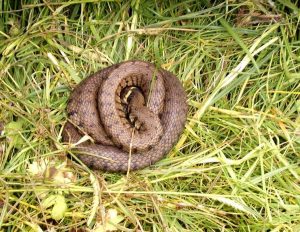 The only snake
really likely to be seen on YACWAG reserves and more generally in the local lowland area is the grass snake, which likes long damp grass, rhyne banks and also hunting in the water itself. They are completely harmless and feed on
amphibians, other reptiles and sometimes mammals like mice and voles, or baby birds like moorhens or ducklings.
The only snake
really likely to be seen on YACWAG reserves and more generally in the local lowland area is the grass snake, which likes long damp grass, rhyne banks and also hunting in the water itself. They are completely harmless and feed on
amphibians, other reptiles and sometimes mammals like mice and voles, or baby birds like moorhens or ducklings.
Grass snakes need somewhere warm to lay their eggs, such as a compost heap or manure heap, but these are becoming less common in the wider countryside. YACWAG has in the past tried to create grass snake egg-laying sites on some of its reserves but
this is an area where a key volunteer could make a difference for wildlife with minimum effort.
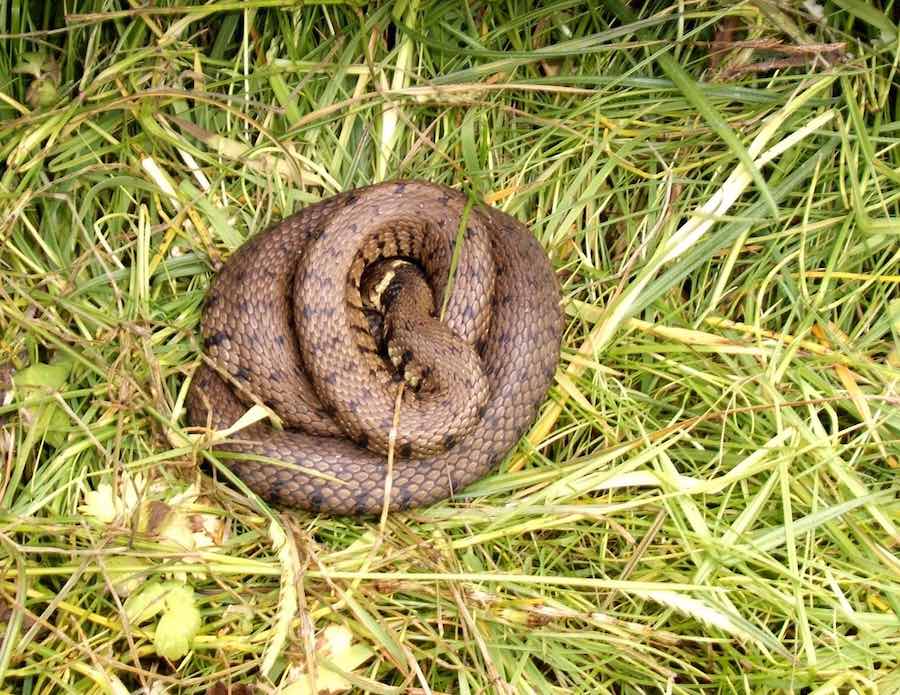
Adder – Vipera berus
Adders are known historically from Cadbury Hill, the woods around Cleeve, Wrington and Congresbury and other areas of higher ground. They are not a lowland species and are generally in more open areas. Adders have not been recorded for many years in the locality and it is likely that they are now extinct.
Common lizard – Lacerta vivipara
Common lizards were at one time abundant along the ballast of the railway embankment at Yatton, and even along the Strawberry Line when it was more open and sunny. YACWAG knows of no recent records. Lizards are a dull brown with black markings, often broken stripes. They need to bask in the sun, like all reptiles, and hibernate in the winter in cracks and stones. Lizards can shed their tails when threatened by a predator and a new tail grows slowly from the stump.
Slow worm – Anguis fragilis
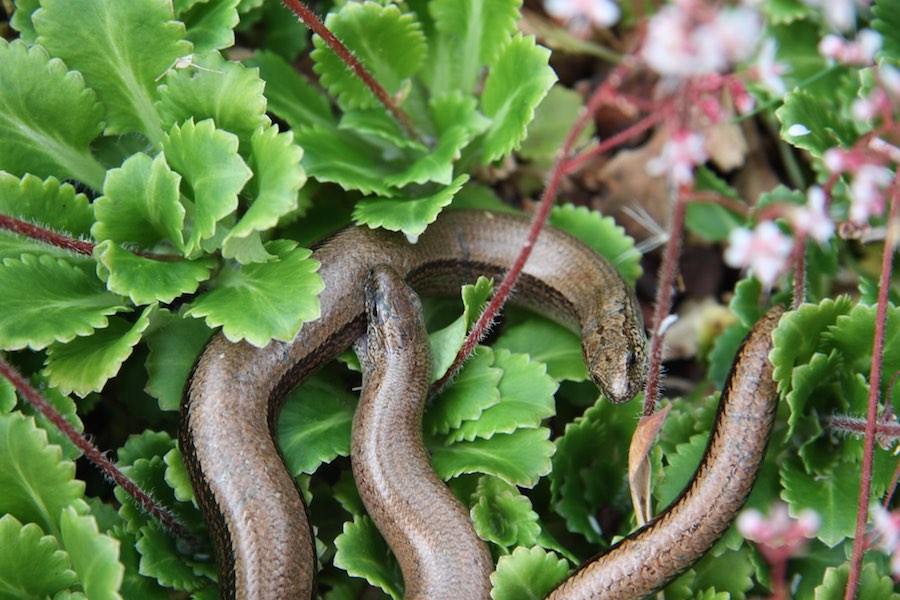 Not a worm, but a lizard with no legs, the slow worm is protected in law against harm. Many people mistake slow worms for snakes and some people wish them harm, even though they eat slugs in the village gardens. Slow worms like sunny banks where there is good cover, so they do well along the Strawberry Line and on the southern slopes of Cadbury Hill. They are known from gardens in Yatton and Congresbury and there is a good colony in St Mary’s Churchyard, Yatton.
Not a worm, but a lizard with no legs, the slow worm is protected in law against harm. Many people mistake slow worms for snakes and some people wish them harm, even though they eat slugs in the village gardens. Slow worms like sunny banks where there is good cover, so they do well along the Strawberry Line and on the southern slopes of Cadbury Hill. They are known from gardens in Yatton and Congresbury and there is a good colony in St Mary’s Churchyard, Yatton.
From time to time YACWAG has carried out surveys under the guidance of an ecologist using squares of roof felt. The slow worms find these good warm spots in which to shelter safe from predators. Older males are greyer, more muscular, and often have blue spots, while females are slimmer usually with a paler back with a dark stripe. On Cadbury Hill many slow worms have been found in the past few years, including some with a blue coloration.

Froglife is a national wildlife conservation charity concerned with the conservation of the UK’s amphibian and reptile species and their associated habitats.
© Copyright YACWAG, or original authors. All rights reserved. | Registered charity 1076362 | Privacy policy | Cookie policy | Terms & Conditions |Web design: StanfordGraphics
